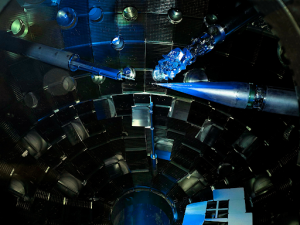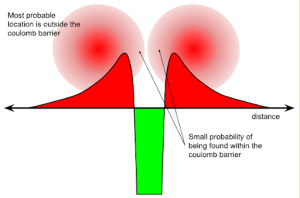How Lasers Could Solve the World Energy Crisis
Written by: Colin Ward
On August 8th, an experiment by the National Ignition Facility made an astounding discovery in nuclear fusion when they came closer than ever before to “igniting” a nuclear fusion reaction, the very same reaction that powers our sun. Ignition is a term used when a fusion reaction yields more energy than is required to initiate it. This means that they are coming closer to providing a potentially monumental source of clean energy that might be able to solve the world’s energy crisis.
The Conventional Method
Nuclear fusion is conventionally achieved through two main elements: temperatures six times hotter than the sun’s core (despite being the very method of energy production for the sun), and an extreme amount of pressure. Fortunately, humans are able to recreate these conditions at the National Ignition Facility.
The National Ignition Facility (NIF) is: “the world’s most precise and reproducible laser system. It precisely guides, amplifies, reflects, and focuses 192 powerful laser beams into a target about the size of a pencil eraser in a few billionths of a second, delivering more than 2 million joules of energy…” This facility, which is the size of three football fields, is a miracle of engineering in and of itself, as it is capable of heating its target to more than 180 million degrees Fahrenheit, an impressive feat.
By focusing the lasers of the NIF on a capsule less than five millimeters in diameter, the scientists were able to create a fusion reaction. This reaction, despite returning only 70% of the energy of the laser used to ignite it, actually created more energy than it absorbed, as some of the lasers’ energy was lost during the ignition process, and not put into igniting the reaction.
Figure 1

The NIF’s lasers converge on a singular, minuscule point, shown here
Source: [Science.org]
The Unconventional Method
As previously mentioned, fusion is the very same process that the sun uses to power itself. But, given the required temperature (six times hotter than the sun’s core), how is it possible for the sun to achieve this? The not so simple answer is “quantum tunneling.”
The coulomb barrier is heavily involved in this process. This is the barrier that prevents protons lacking enough kinetic energy (in this case heat) from becoming attracted to one another. Given that these protons will nearly never cross this barrier on their own due to lack of energy in the sun , quantum tunneling is used to move them through the barrier, allowing them to become attracted to each other and begin a fusion reaction. Due to the uncertainty of the location of protons, on exceptionally rare occasions a proton will end up across the coulomb barrier without having the energy typically required to do so. This is called quantum tunneling, as it is as though the proton had tunneled directly through the coulomb barrier.
Given this abysmally low probability, this is not a feasible process of energy generation here on earth, but it occurs within the sun rather frequently due to the immense quantity of protons capable of quantum tunneling.
Figure 2

A representation of how the coulomb barrier works
Source: [Mr. Toogood’s Physics]
What Does This Mean for Renewable Energy?
Should it be properly achieved, fusion energy would be one of the best energy sources for the world, as it doesn’t produce greenhouse gases or radioactive waste. This recent experiment produced eight times the amount of power as previous ones, potentially indicating more rapid progress towards fusion energy. Despite this, scientists believe large-scale fusion power to be a long way off, as laser plasma physicist Stuart Mangles stated, “There will be a huge amount of work needed to turn the technology into a viable source of energy.”
References and Sources
Bishop, B. (2021, August 18). National Ignition Facility Experiment puts researchers at threshold of fusion ignition. LLNL. Retrieved October 14, 2021, from https://www.llnl.gov/news/national-ignition-facility-experiment-puts-researchers-threshold-fusion-ignition.
Conover, E. (2021, August 23). With a powerful laser blast, scientists near a nuclear fusion milestone. Science News. Retrieved October 14, 2021, from https://www.sciencenews.org/article/laser-nuclear-fusion-experiment-energy.
Kiger, P. J., & Freudenrich, C. C. (2021, January 26). How nuclear fusion reactors work. HowStuffWorks Science. Retrieved October 14, 2021, from https://science.howstuffworks.com/fusion-reactor2.htm.
Lawrence Livermore National Laboratory. (2021, August 24). National Ignition Facility Breakthrough: Experiment puts researchers at threshold of fusion ignition. SciTechDaily. Retrieved October 14, 2021, from https://scitechdaily.com/national-ignition-facility-breakthrough-experiment-puts-researchers-at-threshold-of-fusion-ignition/.
Toogood, O. (n.d.). Mr. Toogood’s physics. Extension – IS the Sun hot enough for fusion? Retrieved October 14, 2021, from http://www.alevelphysicsnotes.com/astrophysics/is%20the%20sun%20hot%20enough.php.
What Is the National Ignition Facility? What is the National Ignition Facility? (n.d.). Retrieved October 20, 2021, from https://lasers.llnl.gov/about/what-is-nif.